Can IoTex, the 7-year-old Internet of Things blockchain, usher in a second spring?
After the upgrade, IoTeX 2.0 aims to become a unified DePIN network architecture infrastructure.
 JinseFinance
JinseFinance
Product competition in the AI era cannot be separated from the resource side (computing power, data, etc.), especially It is supported by stable resource side.
Model training/iteration also requires a huge number of user targets (IP) to help feed data to produce a qualitative change in model efficiency.
The combination with Web3 can help small and medium-sized AI start-up teams achieve overtaking of traditional AI giants.
For the DePIN ecosystem, resources such as computing power and bandwidth determine the lower limit (simple computing power integration has no moat); the application and in-depth optimization of AI models (similar to BitTensor) Dimensions such as specialization (Render, Hivemaper) and effective use of data determine the upper limit of the project.
In the context of AI+DePIN, model inference & fine-tuning, as well as the mobile AI model market will receive attention.
AI Market Analysis & Three Questions
According to statistics, from September 2022, the eve of the birth of ChatGPT, to August 2023, the world's top 50 AI products have generated more than 24 billion visits, with an average of Monthly growth is 236.3 million times.
Behind the prosperity of AI products is the increasing dependence on computing power.
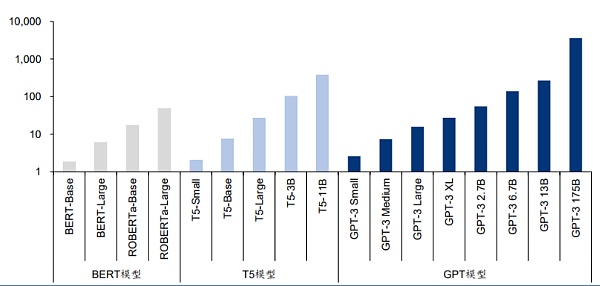
Source: "Language Models are Few-Shot Learners"
University of Massachusetts A paper from the University of Amherst states that "training an artificial intelligence model can emit as much carbon as five cars over its lifetime." However, this analysis only involved a single training. As the model improves through repeated training, energy usage will increase significantly.
The latest language models contain billions or even trillions of weights. One popular model, GPT-3, has 175 billion machine learning parameters. Using the A100 would require 1,024 GPUs, 34 days, and $4.6 million to train the model.
Product competition in the post-AI era has gradually expanded into a resource-side war focused on computing power.

Source: AI is harming our planet: addressing AI's staggering energy cost
This leads to three questions: First, whether an AI product has enough resources (computing power, bandwidth, etc.), especially stable resources, to support it. Such reliability requires decentralization with sufficient computing power. In the traditional field, due to the gap in the demand side of chips, coupled with the world wall built based on policies and ideology, chip manufacturers are naturally in an advantageous position and can significantly drive up prices. For example, the NVIDIA H100 model chip has increased from US$36,000 to US$50,000 in April 2023, which further increases the cost of the AI model training team.
The second problem is that meeting resource-side conditions helps AI projects solve the rigid needs of hardware, but model training/iteration also requires huge user targets. (IP) to help feed the information. After the model size exceeds a certain threshold, the performance on different tasks shows breakthrough growth.
The third problem is: it is difficult for small and medium-sized AI start-up teams to overtake in corners. The monopoly of computing power in the traditional financial market has also led to the monopoly of AI model solutions. Large AI model manufacturers represented by OPenAI, Google Deepmind, etc. are further building their own moats. Small and medium-sized AI teams need to seek more differentiated competition.
The answers to the above three questions can be found in Web3. In fact, the combination of AI and Web3 has a long history, and the ecosystem is relatively prosperous.
The picture below shows some of the tracks & projects of the AI+Web3 ecosystem produced by Future Money Group.
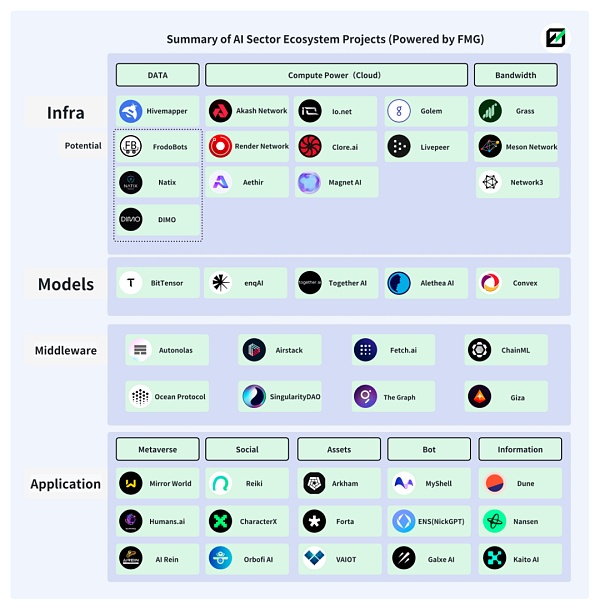
DePIN is the abbreviation of decentralized physical infrastructure network. It is also a collection of production relations between people and equipment, through the combination of token economics and hardware equipment (such as computers, car cameras, etc.) , to organically combine users and equipment while achieving the orderly operation of the economic model.
Compared to the more broadly defined Web3, because DePIN is naturally more closely related to hardware devices and traditional enterprises, DePIN is attracting off-site AI teams and related There are natural advantages in terms of funds.
DePIN ecology’s pursuit of distributed computing power and incentives for contributors exactly solve the needs of AI products for computing power and IP.
DePIN uses token economics to promote the world’s computing power (calculation The settlement of power centers & idle personal computing power) reduces the risk of centralization of computing power and at the same time reduces the cost of using computing power for the AI team.
The large and diversified IP composition of the DePIN ecosystem helps the AI model achieve the diversity and objectivity of data acquisition channels, which is sufficient Multiple data providers can also ensure the improvement of AI model performance.
The overlap in portraits between DePIN ecological users and Web3 users can help settled AI projects develop more Web3-enabled products Unique AI models create differentiated competition, which is not available in the traditional AI market.
In the Web2 field, AI model data collection usually comes from public data sets or collected by the model producers themselves, which will be affected by cultural Background and geographical restrictions cause subjective "distortion" in the content produced by the AI model. Traditional data collection methods are limited by collection efficiency and cost, making it difficult to obtain a larger model scale (number of parameters, training time and data quality). For AI models, the larger the scale of the model, the easier it is for the performance of the model to change qualitatively.

Source: Large Language Models' emergent abilities: how they solve problems they were not trained to address?
DePIN happens to have a natural advantage in this area. Take Hivemapper as an example. It is distributed in 1,920 regions around the world, and nearly 40,000 contributors are providing data for MAP AI (map AI model).
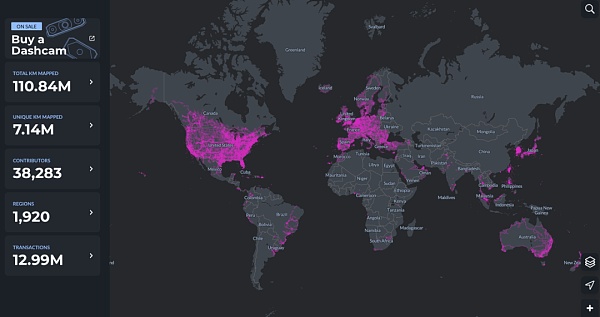
The combination of AI and DePIN also means that the integration of AI and Web3 has reached a new level. Currently, AI projects in Web3 are widely used on the application side, and have hardly got rid of their direct dependence on Web2 infrastructure. They will implant existing AI models that rely on traditional computing power platforms into Web3 projects. The creation of AI models is Rarely involved.
Web3 elements have always been in the lower reaches of the food chain and cannot obtain real excess returns. The same is true for distributed computing power platforms. Pure AI + computing power cannot truly tap the potential of the two. In this relationship, computing power providers cannot obtain more excess profits, and the ecological structure is too simple. Therefore, it is impossible to use token economics to make the flywheel run.
But the AI+DePIN concept is breaking this inherent relationship and shifting Web3's attention to broader AI models.
We can boldly make a definition: providing complete objective conditions (computing power/bandwidth/data/IP) for AI and providing AI models (training/inference/ Fine-tuning) scenarios and projects that are given token economics can be defined as AI+DePIN.
Future Money Group will list the following classic paradigms of AI+DePIN to sort out.

We divide it into four sectors: computing power, bandwidth, data, and other sectors according to different types of resource provision, and try to sort out the projects in different sectors.
The computing power end is AI+ The main component of the DePIN sector is also the part with the largest number of projects currently. For computing power projects, the main components of computing power are GPU (graphics processing unit), CPU (central processing unit) and TPU (professional machine learning chip). Among them, TPU is mainly built by Google due to its high manufacturing difficulty. It only provides external cloud computing power leasing services, so the market size is small. The GPU is a hardware component similar to the CPU, but more professional. It can handle complex mathematical operations running in parallel more efficiently than a regular CPU. Originally GPUs were designed to handle graphics rendering tasks in games and animations, but now they are used for much more than that. Therefore, GPU is currently the main source of computing power market.
Therefore, many of the AI+DePIN projects we can see in terms of computing power specialize in graphics and video rendering, or related games. This is Due to the characteristics of the GPU.
From a global perspective, the main providers of computing power for AI+DePIN products are composed of three parts: traditional cloud computing power service providers; idle individuals Computing power; own computing power. Among them, cloud computing power service providers account for the largest share, followed by idle personal computing power. This means that such products more often act as computing power intermediaries. On the demand side are various AI model development teams.
At present, in this category, almost 100% of the computing power cannot be used in practice, and most of the time it is idle. For example, in Akash Network, about 35% of the computing power is currently in use, and the rest of the computing power is idle. io.net is in a similar situation.
This may be caused by the current small number of AI model training requirements, and it is also the reason why AI+DePIN can provide cheap computing power costs. As the AI market expands in the future, this situation will improve.
Akash Network is a decentralized peer-to-peer cloud service marketplace, often referred to as the Airbnb of cloud services. The Akash network allows users and companies of all sizes to use their services quickly, stably and affordably.
Similar to Render, Akash also provides users with services such as GPU deployment, leasing, and AI model training.
In August 2023, Akash launched Supercloud, allowing developers to set the price they are willing to pay to deploy their AI models, while those with additional computing power The provider hosts the user's model. The feature is very similar to Airbnb, allowing providers to rent out unused capacity.
Through open bidding, resource providers are encouraged to open up idle computing resources in their networks, Akash Network achieves more efficient use of resources, thereby providing resource needs Fang offers more competitive prices.

The current total number of Akash ecological GPUs is 176 GPUs, but the active number is 62, and the activity level is 35%, which is lower than the 50% level in September 2023. Estimated daily income is around US$5,000. AKT tokens have a pledge function. Users can participate in the maintenance of network security by pledging tokens and obtain an annualized return of about 13.15%.
Akash's data performance in the current AI+DePIN sector is relatively high, and its US$700 million FDV has greater room for growth compared to Render and BitTensor.
Akash has also connected to BitTensor's Subnet to expand its own development space. Overall, Akash’s project, as one of several high-quality projects on the AI+DePIN track, has excellent fundamental performance.
io.net is a decentralized computing network that enables the development, execution and scaling of ML (machine learning) applications on the Solana blockchain, leveraging the world's largest GPU cluster to allow machine learning engineers to Rent and access distributed cloud service computing power at a fraction of the cost of centralized services.
According to official data, io.net has more than 1 million GPUs on standby. In addition, io.net's cooperation with Render also expands the GPU resources available for deployment.
io.net ecosystem has many GPUs, but almost all of them come from cooperation with various cloud computing vendors and access to personal nodes, and the idle rate is relatively high. High. Taking the RTX A6000, which has the largest number of GPUs, as an example, only 11% (927) of the 8426 GPUs are in use, while almost no one uses more types of GPUs. But one of the major advantages of current io.net products is that they are cheaply priced. Compared with Akash’s GPU call cost of US$1.5 per hour, the lowest cost on io.net can be between US$0.1-1.

In the future, io.net will also consider allowing GPU providers in the IO ecosystem to increase the chance of being used by mortgaging native assets. The more assets you invest, the greater your chances of being selected. At the same time, AI engineers who pledge native assets can also use high-performance GPUs.
In terms of GPU access scale, io.net is the largest among the 10 projects listed in this article. In addition to the idle rate, the number of GPUs in use also ranks first. In terms of token economics, the io.net native token and protocol token IO will be launched in the first quarter of 2024, with a maximum supply of 22,300,000. Users will be charged a 5% fee for using the network, which will be used in Burn IO tokens or to provide incentives for new users on both the supply and demand sides. The token model has obvious pull-up characteristics, so although io.net has not issued a token, the market is very popular.
Golem is a decentralized computing power market that allows anyone to share and aggregate computing resources by creating a network of shared resources. Golem provides users with computing power rental scenarios.
The Golem market is composed of three parties, namely the computing power supplier, the computing power demand side, and the software developers. The computing power demander submits the computing task, and the Golem network allocates the computing task to the appropriate computing power supplier (providing RAM, hard disk space, CPU cores, etc.). After the computing task is completed, both parties make payment and settlement through Token.

Golem mainly uses CPUs for computing power stacking, although the cost is lower than that of GPUs (Inter i9 14900k costs about $700, while A100 GPUs cost $12,000-25,000). However, the CPU cannot perform high-concurrency operations and consumes higher energy. Therefore, using CPU to rent computing power may have a slightly weaker narrative than a GPU project.
Magnet AI By integrating GPU computing power providers, we provide model training services for developers of different AI models. Unlike other AI+DePIN products, Magent AI allows different AI teams to issue ERC-20 tokens based on their own models. Users can obtain different model token airdrops and additional rewards by participating in different model interactions.
In Q2 2024, Magent AI will be launched on Polygon zkEVM & Arbrium.
It is somewhat similar to io.net. It mainly integrates GPU computing power and provides model training services for AI teams.
The difference is that io.net focuses more on the integration of GPU resources, encouraging different GPU clusters, enterprises and individuals to contribute GPUs while receiving rewards, which is computing power drive.
Magent AI seems to focus more on AI models. Due to the existence of AI model tokens, it may focus on tokens and airdrops to complete user attraction and retention, and Through this way of assetizing AI models, we will promote the entry of AI developers.
Simple summary: Magnet is equivalent to building a marketplace with GPUs, where any AI developer or model deployer can issue ERC-20 tokens. Users can acquire different tokens or actively hold different tokens.
Render Network is a decentralized GPU-based rendering solution provider that aims to connect creators and idle GPU resources through blockchain technology to eliminate hardware limitations, reduce time and costs, while providing digital rights management, further promoting the Metaverse development of.
According to the Render white paper, based on Render, artists, engineers and developers can create a series of AI applications, such as AI-assisted 3D content generation and AI-accelerated rendering of the entire system. , and use Render's 3D scene graph data to train related AI models.
Render provides Render Network SDK for AI developers. Developers will be able to use Render's distributed GPU to perform rendering from NeRF (Neural Reflection Field) and LightField AI computing tasks from process to generative AI tasks.
According to a report by Global Market Insights, the global 3D rendering market is expected to reach US$6 billion. Compared with FDV's US$2.2 billion Render, there is still room for development.
Currently, the specific data of Render based on GPU cannot be found, but because the OTOY company behind Render has shown its correlation with Apple several times; coupled with its extensive business OctaneRender, OTOY's star renderer, supports all industry-leading 3D toolsets in the fields of VFX, games, motion design, architectural visualization and simulation, including native support for Unity3D and Unreal engines.
As well as Google and Microsoft have joined the RNDR network. Render processed nearly 250,000 rendering requests in 2021, and artists in the ecosystem generated about $5 billion in sales through NFT.
Therefore, the reference valuation of Render should be compared with the pan-rendering market potential (approximately US$30 billion). Coupled with the BME (Burning and Minting Balance) economic model, Render still has some room for growth, whether in terms of pure token price or FDV.
Clore.ai It is a platform based on PoW that provides GPU computing power rental services. Users can rent out their own GPUs for tasks such as AI training, video rendering, and cryptocurrency mining, and others can acquire this power at a low price.
Business scope includes: artificial intelligence training, movie rendering, VPN, cryptocurrency mining, etc. When there is a demand for specific computing power services, the tasks assigned by the network are completed; if there is no demand for computing power services, the network finds the cryptocurrency with the highest mining yield at that time and participates in mining.

Clore.ai's number of GPUs has increased from 2,000 to about 9,000 in the past six months, but in terms of the number of GPU integrations, Clore.ai surpasses Akash. However, its secondary market FDV is only about 20% of Akash.
In terms of token model, CLORE adopts POW mining mode, without pre-mining and ICO. 50% of each block is allocated to miners and 40% to miners. For renters, 10% is allocated to the team.
The total number of tokens is 1.3 billion. Mining will begin in June 2022 and will basically enter full circulation by 2042. The current circulation is approximately 220 million. . The circulating supply at the end of 2023 will be approximately 250 million, accounting for 20% of the total token supply. Therefore, the current actual FDV is US$31 million. In theory, Clore.ai is seriously undervalued. However, due to its token economics, the miner allocation ratio is 50%, and the mining, selling and raising ratio is too high, so the currency price has a great potential to increase. resistance.
Livepeer is based on Ethereum’s decentralized video protocol rewards parties that securely process video content at a reasonable price.
According to officials, Livepeer has thousands of GPU resources to transcode millions of minutes of video every week.
Livepeer may adopt a "mainnet" + "subnet" approach, allowing different node operators to generate subnets and cash out payments on the Livepeer mainnet to perform these tasks. For example, the AI video subnet is introduced for AI model training specifically in the field of video rendering.
Livepeer will later expand the AI-related parts from simple model training to inference & fine-tuning.
Aethir It is a cloud gaming platform and a decentralized cloud infrastructure (DCI) specially built for gaming and artificial intelligence companies. It helps deliver heavy GPU computing loads on behalf of players, ensuring gamers get an ultra-low latency experience anywhere and on any device.
At the same time, Aethir provides deployment services including GPU, CPU, disk and other elements. On September 27, 2023, Aethir officially provided commercial services of cloud gaming and AI computing power to global customers, integrating decentralized computing power to provide computing power support for games and AI models on its own platform.
Cloud gaming eliminates the limitations of terminal device hardware and operating systems by transferring computing power requirements for rendering to the cloud, significantly expanding the potential player base. scale.
Bandwidth is provided by DePIN to AI One of the resources, the global bandwidth market will exceed US$50 billion in 2021, and is predicted to exceed 100 billion in 2027.
Due to the increasing number and complexity of AI models, model training usually adopts a variety of parallel computing strategies, such as data parallelism, pipeline parallelism, tensor parallelism, etc. . In these parallel computing modes, the importance of collective communication operations among multiple computing devices has become increasingly important. Therefore, when building large-scale training clusters for large AI models, the role of network bandwidth becomes prominent.
More importantly, a stable and sufficiently reliable bandwidth resource can ensure simultaneous response between different nodes, technically avoiding the emergence of a single point of control ( For example, Falcon uses a low-latency + high-bandwidth relay network model to seek a balance between latency and bandwidth requirements), ultimately ensuring the trustworthiness and censorship resistance of the entire network.
Grass is the flagship product of Wynd Network, which focuses on open network data and raised US$1 million in financing in 2023. Grass allows users to earn passive income from their Internet connections by selling unused network resources.
Users can sell Internet bandwidth on Grass, provide bandwidth services to AI development teams in need, help AI model training, and obtain token returns.
Currently, Grass is about to launch a mobile version. Since the mobile version and the PC version have different IP addresses, this means that Grass users will be provided with more information for the platform at the same time. More IP addresses, and Grass will collect more IP addresses to provide better data efficiency for AI model training.
Currently, Grass has two ways to provide IP addresses: PC download extension program, and mobile APP download. (PC and mobile terminals need to be on different networks)
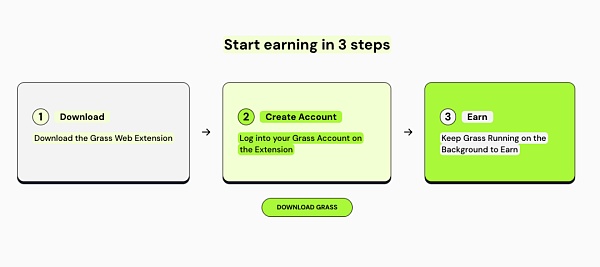
As of November 29, 2023, the Grass platform has 103,000 downloads and 1,450,000 unique IP addresses.
Mobile terminals and PC terminals have different demands for AI, so the applicable AI model training categories are different.
For example, the mobile terminal has a large amount of data on image optimization, face recognition, real-time translation, voice assistants, device performance optimization, etc. These are difficult to provide on the PC side.
Currently, Grass is in a relatively pioneer position in mobile AI model training. Considering the huge potential of the mobile market on a global scale, the prospects of Grass are worthy of attention.
However, Grass has not yet provided more effective information on the AI model. It is speculated that mining coins may be the main mode of operation in the early stage.
Meson Network is a next-generation storage acceleration network based on blockchain Layer 2. It aggregates idle servers through mining, schedules bandwidth resources, and serves the file and streaming media acceleration markets, including traditional websites, videos, live broadcasts, and regional Blockchain storage solution.
We can understand Meson Network as a bandwidth resource pool, and both sides of the pool can be regarded as the supply and demand sides. The former contributes bandwidth and the latter uses bandwidth.
In Meson's specific product structure, there are two products (GatewayX, GaGaNode) responsible for receiving the bandwidth contributed by different nodes around the world, and one product (IPCola) It is responsible for monetizing these aggregated bandwidth resources.
GatewayX: Mainly integrates commercial idle bandwidth, mainly targeting IDC centers.
From Meson's data dashboard, we can find that the currently connected IDC has more than 20,000 nodes around the world, and has formed a 12.5Tib/s Data transfer capabilities.
GaGaNode: Mainly integrates idle bandwidth of residential and personal devices and provides edge computing assistance.
IPCola: Meson’s monetization channel, which performs tasks such as IP and bandwidth allocation.

Meson currently revealed that its half-year revenue is over one million US dollars. According to official website statistics, Meson has 27,116 IDC nodes and an IDC capacity of 17.7TB/s.
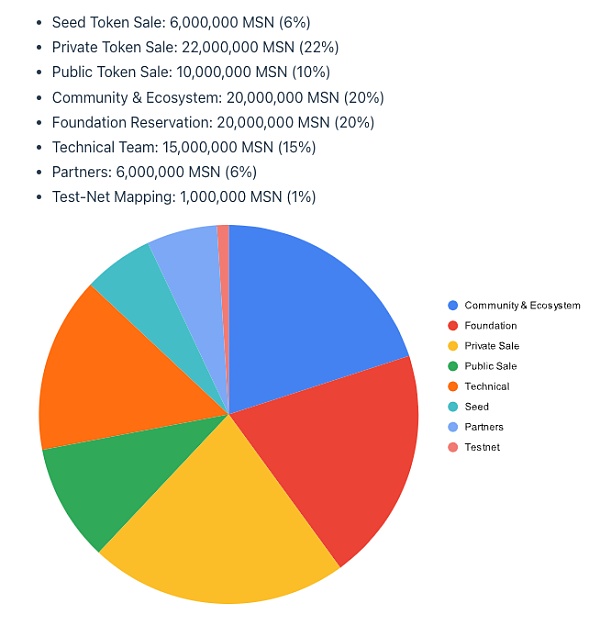
Meson currently expects to issue tokens in March-April 2024, but has announced token economics.
Token name: MSN, initial supply is 100 million, mining inflation rate is 5% in the first year, decreasing by 0.5% every year.
Network3 is An AI company that built a specialized AI Layer 2 and integrated it with Sei. Through AI model algorithm optimization and compression, edge computing and privacy computing, we provide services to AI developers around the world, helping developers quickly, conveniently and efficiently train and verify models on a large scale.
According to official website data, Network3 currently has more than 58,000 active nodes, providing 2PB of bandwidth services. Reached cooperation with 10 blockchain ecosystems including Alchemy Pay, ETHSign, and IoTeX.
Different from computing power and bandwidth, The current market for data terminal supply is relatively niche. And has a distinct professionalism. The demand group is usually the project itself or the AI model development team of related categories. Such as Hivemapper.
Training your own map model through feeding your own data is not logically difficult, so we can try to broaden our horizons to something similar to Hivemapper DePIN projects, such as DIMO, Natix and FrodoBots.
HiveMapper is one of the top DePIN concepts on Solana and is committed to creating a decentralized "Google Map". Users can obtain HONEY tokens by purchasing the driving recorder launched by HiveMapper, and by using and sharing real-time images with HiveMapper.
About Hivemapper, Future Money Group once reported in "FMG Research Report: 19-fold increase in 30 days, understanding the automotive DePIN industry represented by Hivemapper" Detailed description will not be elaborated here. The reason why Hivemapper is included in the AI+DePIN section is because Hivemapper has launched MAP AI, an AI map production engine that can generate high-quality map data based on the data collected by the driving recorder.
Map AI has set up a new role, AI trainer. This role includes previous driving recorder data contributors and Map AI model trainers.
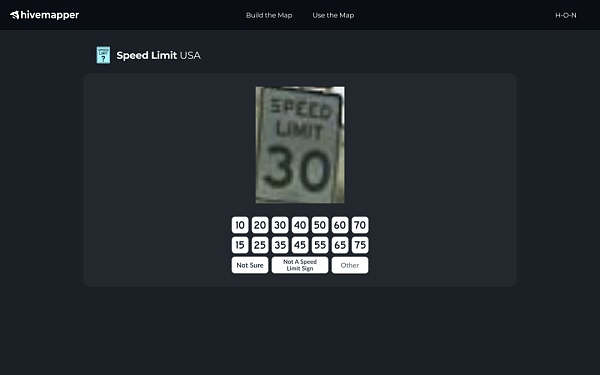
Hivemapper does not deliberately specialize in its requirements for AI model trainers. Instead, it adopts low participation thresholds such as remote tasks, guessing geographical locations and other similar game behaviors to allow more IP addresses to participate. The richer the IP resources of the DePIN project, the more efficient AI will be in acquiring data. Users who participate in AI training can also receive HONEY token rewards.
AI application scenarios in Hivemapper are relatively niche, and Hivemapper does not support third-party model training. Map AI aims to optimize its own map products. Therefore, the investment logic for Hivemapper will not change.
DIMO is an automotive IoT platform built on Polygon that enables drivers to collect and share their vehicle data, record The data includes car kilometers traveled, driving speed, location tracking, tire pressure, battery/engine health and more.
By analyzing vehicle data, the DIMO platform can predict when maintenance is needed and promptly remind users. Drivers not only gain insights into their vehicles, but they can also contribute data to DIMO’s ecosystem and receive DIMO tokens as rewards. Data consumers can extract data from the protocol to understand the performance of components such as batteries, autonomous driving systems and controls.
Natix It is a decentralized network built using AI privacy patents. Based on AI privacy patents, it aims to combine the world with camera devices (smartphones, drones, cars) to create a medium-security camera network, while collecting data under the premise of privacy compliance, and analyzing decentralized dynamic maps. (DDMap) for content filling.
Users who participate in data provision can receive tokens and NFT for incentives.
FrodoBots is a DePIN game that uses mobile robots as a carrier, collects influence data through cameras, and has certain social attributes.
Users purchase robots to participate in the game process and interact with players around the world. At the same time, the robot's own camera will also collect and summarize road and map data.
The above three projects all have two elements: data collection and IP provision. Although they have not yet conducted relevant AI model training, they all provide opportunities for the introduction of AI models. Necessary conditions are provided. These projects, including Hivemapper, require cameras to collect data and form a complete map. Therefore, the adapted AI models are also limited to areas focusing on map construction. The empowerment of AI models will help projects build a higher moat.
What needs to be noted is that camera collection often encounters regulatory issues such as two-way privacy invasion: for example, the collection of external images by external cameras affects the portrait rights of passers-by. definition; and the importance users attach to their own privacy. For example, Natix operates AI for privacy protection.
Computing power, bandwidth, and data focus The distinction is based on the resource side, while the algorithm focuses on the AI model. This article takes BitTensor as an example. BitTensor neither directly contributes data nor computing power. Instead, it schedules and screens different algorithms through the blockchain network and incentive mechanism, thus allowing the AI field to form a free competition and A model marketplace for knowledge sharing.
Similar to OpenAI, BitTensor aims to achieve inference performance that matches traditional model giants while maintaining the decentralized characteristics of the model.
The algorithm track is somewhat advanced, and similar projects are rare. When AI models, especially those based on Web3, emerge, competition between models will become normal.
At the same time, competition between models will also increase the importance of reasoning and fine-tuning in the downstream of the AI model industry. AI model training is only the upstream of the AI industry. A model needs to be trained first and have initial intelligence. On this basis, more careful model reasoning and adjustments (can be understood as optimization) are performed on the model before it can finally be used as a finished product. Deploy at the edge. These processes require more complex ecological architecture and computing power support. It also means that the potential development potential is huge.
BitTensor is a The architecture is similar to the decentralized machine learning ecosystem of Polkadot mainnet + subnet.
Working logic: The subnet transmits activity information to the Bittensor API (the role is similar to an oracle), and then the API transmits useful information to the main network, and the main network then Distribute Rewards.
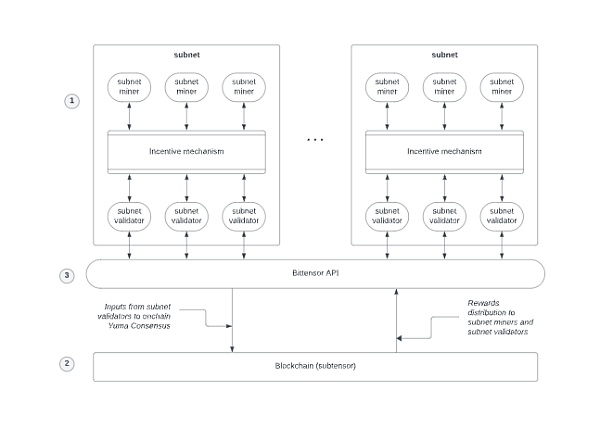

BitTensor 32 subnets
BitTensor ecological role:
Miner : It can be understood as providers of various AI algorithms and models around the world. They host AI models and provide them to the Bittensor network; different types of models form different subnets.
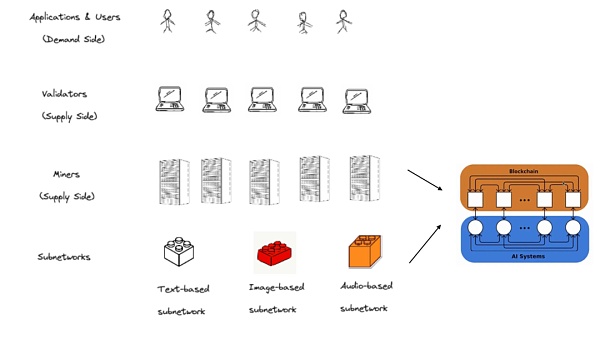
Verifier: Evaluator within the Bittensor network. Evaluate the quality and effectiveness of AI models, rank AI models based on performance on specific tasks, and help consumers find the best solutions.
User: the final user of the AI model provided by Bittensor. It can be an individual, or it can be developers seeking to use AI models for applications.
Nominator: Delegate tokens to a specific verifier to show support, or you can delegate tokens to different verifiers.
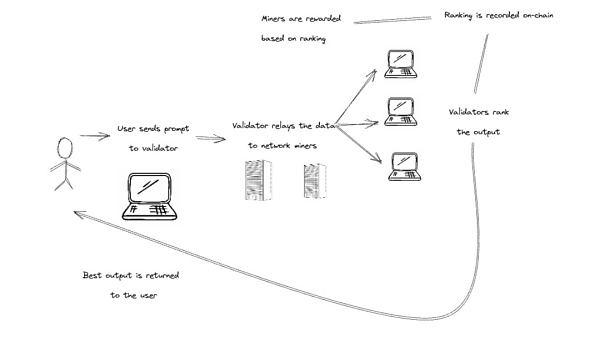
Open AI supply and demand chain: Some people provide different models, some evaluate different models, and some use the results provided by the best model.
Different from roles like "computing power intermediary" like Akash and Render, BitTensor is more like a "labor market", using existing models to absorb more The data is used to make the model more reasonable. Miners and validators are more like "construction parties" and "supervisors". Users ask questions, miners output answers, and verifiers evaluate the quality of the answers and finally return them to users.
BitTensor token is TAO. TAO's market value is currently second only to RNDR, but due to the long-term release mechanism of halving in four years, the ratio of market value to fully diluted value is the lowest among several projects, which also means that TAO's overall circulation is currently relatively small. Low, but the unit price is higher. This means that the actual value of TAO is underestimated.
It is currently difficult to find a suitable valuation target. If we start from the structural similarity, Polkadot (about 12 billion U.S. dollars) is the reference object, and TAO has nearly 8 times. Room for upside.
If we follow the "oracle" attribute and use Chainlink ($14 billion) as the reference object, TAO will have an increase of nearly 9 times.
Conclusion
Overall, AI+DePIN promotes It has understood the paradigm shift of the AI track in the context of Web3, allowing the market to jump out of the inherent thinking of "What can AI do in Web3?" and think about the larger question of "What can AI and Web3 bring to the world?" question.
If NVIDIA CEO Jen-Hsun Huang calls the release of generative large models the "iPhone" moment of AI, then the combination of AI and DePIN means that Web3 is truly welcoming. Come on "iphone" moment.
DePIN, as the most accepted and mature use case of Web3 in the real world, is making Web3 more acceptable.
Due to the partial overlap between IP nodes and Web3 players in the AI+DePIN project, the combination of the two is also helping the industry to generate its own models and models belonging to Web3. AI products. This will be beneficial to the overall development of the Web3 industry and open up new tracks for the industry, such as the reasoning and fine-tuning of AI models, and the development of mobile AI models.
An interesting point is that the AI+DePIN products listed in the article seem to be able to nest the development path of the public chain. In previous cycles, various new public chains emerged, using their own TPS and governance methods to attract various developers.
The same is true for the current AI+DePIN products, which attract various AI model developers based on their own computing power, bandwidth, data and IP advantages. Therefore, we currently see that AI+DePIN products tend to be biased towards homogeneous competition.
The key to the problem is not the amount of computing power (although this is a very important prerequisite), but how to use this computing power. The current AI+DePIN track is still in the early stages of "barbaric growth", so we can have high expectations for the future pattern and product form of AI+DePIN.
References
1.https://www .techopedia.com/decentralized-physical-infrastructure-networks-DePIN-brings-ai-and-crypto-together
2.https://medium.com /meson-network/with-the-increasing-ai-and-DePIN-trends-why-should-you-consider-keeping-an-eye-on-meson-network-59094665c9bd
3.https://medium.com/cudos/the-rise-of-DePIN-unveiling-the-future-of-ai-and-metaverse-compute-requirements-213f7b5b1171
4.https://www.numenta.com/blog/2022/05/24/ai-is-harming-our-planet/
5.https://www.techflowpost.com/article/detail_15398.html
6.https:// www.numenta.com/blog/2022/05/24/ai-is-harming-our-planet/
7.https://mirror.xyz /livepeer.eth/7yjb5osZ28AJ9xvA54bZ4T2hUpNM5O9rrpv-zmGWDZ4
After the upgrade, IoTeX 2.0 aims to become a unified DePIN network architecture infrastructure.
 JinseFinance
JinseFinanceAs the leader of fully circulated Depin, IoTex officially released version 2.0. It has been 7 years since the release of version 1.0.
 JinseFinance
JinseFinanceFounded in 2017, the IoTeX platform is an open source blockchain project built specifically for Internet of Things (IoT) applications.
 JinseFinance
JinseFinanceFrom the perspective of project workflow and protocol design, this article reviews and analyzes the entire process of IoT devices generating data from trustworthiness, verifying stored data, generating proof through calculation, and rolling data to the blockchain.
 JinseFinance
JinseFinanceThe term DePIN was proposed by Messari and refers to Decentralized Physical Infrastructure Networks, that is, decentralized physical infrastructure.
 JinseFinance
JinseFinanceThe launch event, attended by key industry leaders and executives, marked a significant milestone in the evolution of the Nigerian FinTech industry.
 Others
OthersThe Digital Euro Association (DEA) has published a new whitepaper
 Bitcoinist
BitcoinistA closer look at how it all started, the major hard forks, and where Ethereum is headed next.
 cryptopotato
cryptopotatoChairman of the U.S. SEC recently congratulated the whitepaper or Bitcoin white book written by Satoshi Nakamoto, the creator of BTC.
 Others
OthersThe Bitcoin white paper is only 9 pages long, but it contains enough to change the world. Here's how it came to be 13 years ago.
 Cointelegraph
Cointelegraph